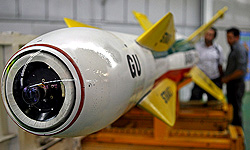|
|
|
The Qassed 2, Iran’s prototype for a laser-guided bomb. |
As the defense buildup in the Persian Gulf continues, Iranian Air Force Commander Brigadier General Hassan Shahsafi announced plans for Iran to test a prototype of the Qassed 2 (Farsi for “messenger”) laser-guided bomb.
Iran’s experimentation with laser-guided bombs began in September 2006 with a series of large-scale war games in Sistan-Baluchistan province. During these games, which were called “Blow of Zolfaqar,” the Qassed 1 — the Islamic Republic’s first “smart bomb” — made its debut.
These war games were coordinated between the Iranian Air Force and Navy, and resulted in the testing of several coast-to-sea, surface-to-surface, and air-to-surface missiles that were all either produced or improved by engineers in the Iranian Defense Ministry. As recently reported by Air Force officials, the Qassed 1 is now in mass production and is ready for distribution to all branches of the armed forces.
The alleged enhancements of the newly unveiled Qassed 2 will include “longer range, more accuracy, and more explosive power,” according to Shahsafi.
Despite Shahsafi’s announcement, it is unknown when the Qassed 2 will make a debut and whether it will be available for mass production in the near future. If history is any guide, the new bomb will not constitute much of an improvement over the previous system and will not be ready for distribution for many years.
The Islamic Republic is notorious for declaring advancements in its arsenal prematurely, as a means of saber-rattling. Many speculate that the announcement of the Qassed 2 is a move of brinksmanship to discourage the Gulf emirate states of Kuwait, Qatar, Bahrain, and UAE from participating in the expansion of the United States’ Patriot missile defense system.
Assuming that the Qassed 2 does make significant improvements upon previous models, the Iranians will also need to overcome the problem of installing these systems on reliable aircraft. The Qassed 1 was originally tested on Tehran’s fleet of aging, American-made, F4 Phantom II aircraft. Before integrating the Qassed 2 into the Air Force, Tehran may have to procure newer aircraft for the delivery of these munitions.
Are you a dedicated reader of FDD's Long War Journal? Has our research benefitted you or your team over the years? Support our independent reporting and analysis today by considering a one-time or monthly donation. Thanks for reading! You can make a tax-deductible donation here.









2 Comments
It still looks like just another repainted Rockwell GBU-15 glide bomb with new wings and strakes, although it does bear some resemblance to the Russian KH-29 series missiles.
Even if they’ve “upgraded”
The seeker head depicted in the photo looks like the electro-optical seeker on an A or B model Maverick, not a laser guided seeker. Agree with “more idle threats”.